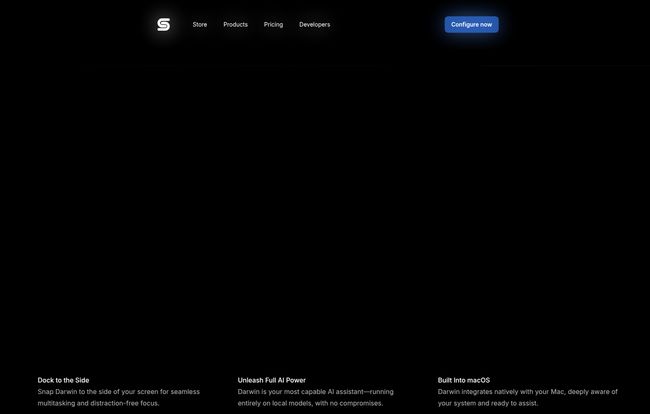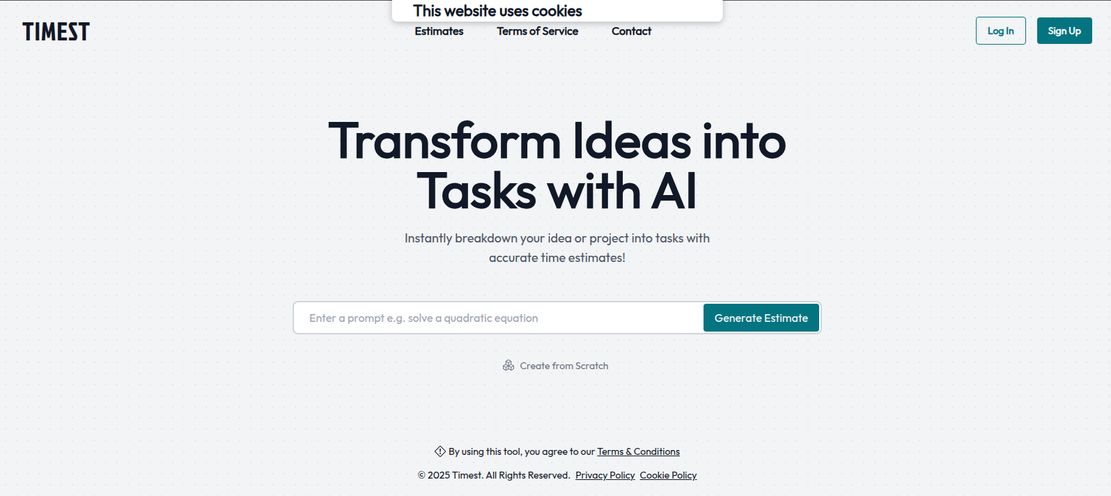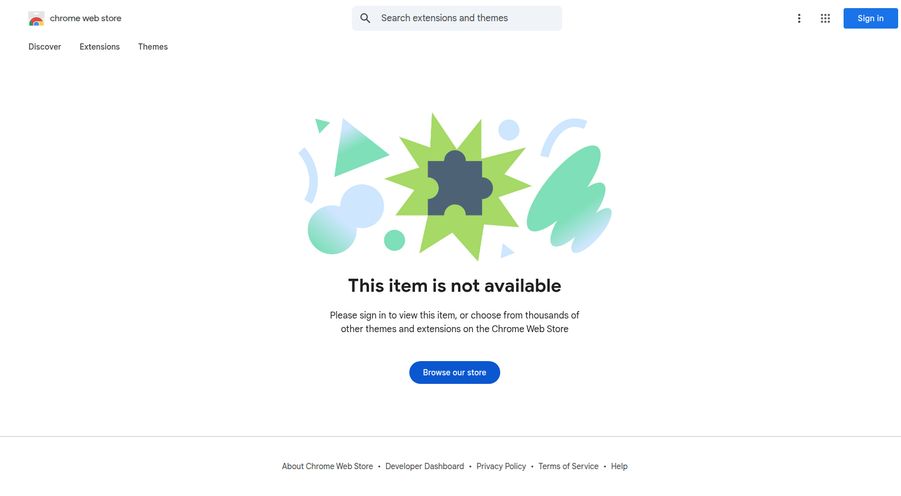For years, I've been in the thick of SEO, traffic gen, and the endless quest for peak productivity. I've tried every app under the sun. To-do lists, window managers, clipboard histories... you name it, I've probably paid for it, used it for a week, and then forgotten it existed. The app graveyard on my Mac is a sad, crowded place.
Most of them promise to change your life but just end up being another window to juggle. Another distraction. And lately, with the AI explosion, we've got a new flavor of promise: AI assistants that want to read your emails, files, and basically your entire digital soul. Which is great, until you start thinking about where all that data is going. Spoiler: it’s usually to a server farm somewhere in Virginia.
So when I stumbled upon Spatio Notch from a company called Spatio Labs, my professional cynicism was on high alert. The pitch? It turns the most useless piece of screen real estate—the MacBook notch—into a dynamic, AI-powered command center. And here's the kicker: it's a local-first AI. My ears perked up. Could this actually be it? An AI that's genuinely helpful and doesn't snoop on my stuff? I had to find out.
So What Exactly is Spatio Notch?
Imagine the notch on your MacBook isn't just a cutout for the camera anymore. Imagine it's a living, breathing part of your OS. That's the core idea here. Spatio Notch, and its built-in AI assistant cleverly named Darwin, transforms that black void into an interactive space. It's written in Swift, so it feels incredibly native, not like some clunky app that was ported over from another universe.
It's always there, waiting. You can ask it things, give it files to summarize, or use it to quickly access system features. Think of it less as an application you open and more as an extension of your own brain, embedded right into the top of your screen. It's the closest thing I've seen to Apple’s own Dynamic Island on the iPhone, but honestly, maybe more useful.

Visit Spatio Notch
The Things I Genuinely Love About It
I'm a tough critic, but after spending some quality time with Darwin, a few things really stand out.
That Local-First Privacy is Everything
This is the big one for me. In an industry where data is the new oil, the idea of a local-first AI is a breath of fresh air. All the processing, all the summarization, all the “thinking” Darwin does happens right on my machine. It’s not sending my client briefs or my confidential keyword research reports to the cloud. That peace of mind is, frankly, priceless. It’s the difference between talking to a trusted colleague in a private office versus shouting your secrets in a crowded stadium. Spatio Labs seems to get that, and I'm here for it.
It Feels Like Part of macOS
You know that feeling when an app just… fits? That's Spatio Notch. Because it’s built natively, there’s no weird lag or awkward interface. It's smooth. It integrates with macOS on a deep level, aware of the system and its functions. You can dock it to the side of your screen, and it just snaps into place, looking like it was always meant to be there. It's not just another app fighting for your attention; it's a quiet, competent partner.
The Dynamic Notch and Notch Tray are Surprisingly Practical
I’ll admit, I thought the whole “put stuff in the notch” thing might be a gimmick. I was wrong. The ability to customize the UI in the notch is cool, but the real power is the Notch Tray. I can just drag a file—a PDF, a text document, whatever—and drop it into the notch. Darwin then has it, ready to work. The other day, a client sent me a 30-page market analysis. Instead of opening it, skim-reading for an hour, I just dropped it onto Darwin and asked for the key takeaways and competitor mentions. I got a bulleted list in about 15 seconds. That single action probably saved me an hour of tedious work. That's not a gimmick; that’s a superpower.
Okay, Let's Be Real, It's Not Perfect
As much as I'm enjoying it, it's not a magical silver bullet. There are a few things you need to know before you jump in.
- The Notch Police: First and foremost, you need a Mac with a notch. If you're running an older MacBook Pro or a lovely M1 MacBook Air, you're out of luck. This is a very specific tool for a specific set of hardware, which is a bit of a bummer.
- There's a Small Learning Curve: It’s not super complicated, but to really get the most out of it, you need to spend a little time understanding its capabilities and how to phrase your requests to Darwin. It's not a huge hurdle, but don't expect to be a wizard in the first five minutes.
- Local Has Its Limits: The flip side of that amazing local-first privacy is that Darwin's power is limited by the AI models running on your Mac. It's incredibly capable for summaries and system tasks, but it's not going to be as massively powerful as something like GPT-4 running on a supercomputer cluster. For 95% of my tasks, it's more than enough. But it’s something to be aware of.
The Big Question: What's The Price Tag?
Alright, let's talk money. This is often the dealbreaker, and Spatio Labs has a tiered approach that's… interesting. For most of us—individuals, freelancers, productivity enthusiasts—you're looking at the Individual License.
| Plan | Price | Best For |
|---|---|---|
| Individual | $99 (one-time) | Personal use, basic coding help, and general productivity. |
| Individual Developer | $499 / month | Professional developers needing advanced models and priority support. |
| Team | $7,499 / month | Organizations needing shared resources and team management. |
Honestly, that $99 one-time purchase for the Individual license feels like a bargain. No subscriptions. You buy it, you own it. Given the time it's already saved me, it feels like a solid investment. The jump to the developer and team plans is steep, but that's a whole different ballgame for a different kind of user. For the average person reading this blog, the $99 plan is the one to look at.
My Final Verdict: Should You Invite Darwin to Your Mac?
So, is Spatio Notch another piece of forgotten software destined for my app graveyard? I dont think so. This one feels sticky. It has fundamentally changed a small part of my workflow in a way that reduces friction instead of adding it.
If you're a Mac user with a notch, and you value your privacy as much as your productivity, you should seriously consider it. It’s a beautifully designed, thoughtfully engineered tool that solves a real problem. It makes the AI work for you, on your terms, right on your own machine. It's turned the most maligned feature of modern MacBooks into one of its most powerful assets. And for a one-time fee, it’s one of the best productivity investments I’ve made in a long time.
Frequently Asked Questions
- What is Spatio Notch in simple terms?
- It's an app for notched MacBooks that turns the notch area into an interactive, AI-powered assistant named Darwin. You can use it to summarize files, manage tasks, and access macOS features without opening a new window.
- Is Spatio Notch safe and private to use?
- Yes. Its main selling point is being a "local-first" AI. This means all your data and the AI's processing happen directly on your computer, never sent to the cloud. This makes it highly secure and private.
- Will Spatio Notch work on my old MacBook?
- Unfortunately, no. It is designed specifically for MacBooks that have a camera notch at the top of the screen (like the MacBook Pro 14"/16" and MacBook Air M2/M3 models).
- How much does Spatio Notch cost for a normal user?
- For individual, personal use, the cost is a one-time payment of $99. There is no recurring subscription for the standard individual license.
- What's the difference between Spatio Notch and Darwin?
- Spatio Notch is the name of the tool/platform that integrates into the Mac's notch. Darwin is the name of the AI assistant that powers it.
Conclusion
In a sea of subscription-based, cloud-hungry apps, Spatio Notch is a refreshing outlier. It’s a testament to the idea that powerful software can also be private and respectful of the user. It’s a tool that doesn’t shout for your attention but rather earns it by being quietly brilliant. If you've got the notch, you've got the space. It might be time to put a little genius in there.
Reference and Sources
For more details on the features and pricing, you can visit the official website:



